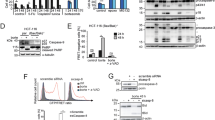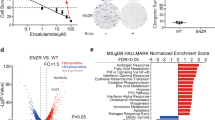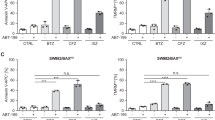Abstract
We demonstrate that PS-341, a small molecule inhibitor of the proteasome, markedly sensitizes resistant prostate, colon, and bladder cancer cells to TNF-like apoptosis-inducing ligand (TRAIL)-induced apoptosis irrespective of Bcl-xL overexpression. PS-341 treatment by itself does not affect the levels of Bax, Bak, caspases 3 and 8, c-Flip or FADD, but elevates levels of TRAIL receptors DR4 and DR5. This increase in receptor protein levels is associated with the ubiquitination of the DR5 protein. When PS-341 is combined with TRAIL, the levels of activated caspase 8 and cleaved Bid are substantially increased. In Bax-negative TRAIL-resistant HC-4 colon cancer cells, the combination of PS-341 and TRAIL overcomes the block to activation of the mitochondrial pathway and causes SMAC and cytochrome c release followed by apoptosis. Similarly, murine embryonic fibroblasts lacking Bax undergo apoptosis when exposed to the combination of PS-341 and TRAIL; however, fibroblasts lacking Bak are significantly resistant. Taken together, these findings indicate that PS-341 enhances TRAIL-induced apoptosis by increasing the cleavage of caspase 8, causing Bak-dependent release of mitochondrial proapoptotic proteins.
This is a preview of subscription content, access via your institution
Access options
Subscribe to this journal
Receive 50 print issues and online access
$259.00 per year
only $5.18 per issue
Buy this article
- Purchase on Springer Link
- Instant access to full article PDF
Prices may be subject to local taxes which are calculated during checkout









Similar content being viewed by others
Abbreviations
- TRAIL:
-
TNF-like apoptosis-inducing ligand
- DISC:
-
death-inducing signaling complex
- PARP:
-
polyADP ribose polymerase
- MEF:
-
murine embryonic fibroblasts
References
Adams J, Palombella VJ, Sausville EA, Joahnson J, Destree A, Lazarus DD, Maas J, Pien CS, Prakash S and Elliott PJ . (1999). Cancer Res., 59, 2615–2622.
An WG, Hwang S-G, Trepel JB and Blagosklonny MV . (2000). Leukemia, 14, 1276–1283.
Bossy-Wetzel E, Newmeyer D and Green DR . (1998). EMBO J., 17, 37–49.
Chomczynski P and Sacchi N . (1987). Anal. Biochem., 162, 156–159.
Chou TC and Talalay P . (1983). Trends Pharmacol. Sci., 4, 450–454.
Cusack JC, Liu R, Houston M, Abendroth K, Elliott PJ, Adams J and Baldwin AS . (2001). Cancer Res., 61, 3535–3540.
Degenhardt K, Sundararajan R, Lindsten T, Thompson C and White E . (2002). J. Biol. Chem., 211, 14127–14134.
Deng Y, Lin Y and Wu X . (2002). Genes Dev., 16, 33–45.
Drabkin HA, Parsy C, Ferguson K, Guilhot F, Lacotte L, Roy L, Zeng C, Baron A, Hunger SP, Varella-Garcia M, Gemmill R, Brizard F, Brizard A and Roche J . (2002). Leukemia, 16, 186–195.
Franco AV, Zhang XD, Van Berkel E, Sanders JE, Zhang XY, Thomas WD, Nguyen T and Hersey P . (2001). J. Immunol., 166, 5337–5345.
Gibson SB, Oyer R, Spalding AC, Anderson SM and Johnson GL . (2000). Mol. Cell. Biol., 20, 205–212.
Govers R, ten Broeke T, van Kerkof P, Schwartz AL and Strous GJ . (1999). EMBO J., 18, 28–36.
Gross A, Yin XM, Wang K, Wei MC, Jockel J, Milliman C, Erdjument-Bromage H, Tempst P and Korsmeyer SJ . (1999). J. Biol. Chem., 274, 1156–1163.
Grotzer MA, Eggert A, Zuzak TJ, Wiewrodt BR, Ho R, Ikegaki N and Brodeur GM . (2000). Oncogene, 19, 4604–4610.
Hakem R, Hakem A, Duncan GS, Henderson JT, Woo M, Soengas MS, Elia A, de la Pompa JA, Kagi D, Khoo W, Kaufman SA, Lowe SW, Penninger JM and Mak TW . (1998). Cell, 94, 339–352.
Hao C, Beguinot F, Condorelli G, Trencia A, Van Meir EG, Yong VW, Praney IF, Roa WH and Petruk KC . (2001). Cancer Res., 61, 1162–1170.
He Q, Luo X, Huang Y and Sheikh MS . (2002). Oncogene, 21, 6032–6040.
Hideshima T, Res Richardson P, Chauhan D, Palombella VJ, Elliott PJ, Adams J and Anderson KC . (2001). Cancer., 61, 3071–3076.
Hietakangas V, Poukkula M, Heiskanen KM, Karvinen JT, Sistonen L and Eriksson JE . (2003). Mol. Cell. Biol., 23, 1278–1291.
Higuchi H, Yoon J-H, Grambihler A, Werneburg N, Bronk SF and Gores GJ . (2003). J. Biol. Chem., 278, 454–461.
Kelly MM, Hoel BD and Voelkel-Johnson C . (2002). Cancer Biol. Ther., 1, 520–527.
Kim Y, Suh N, Sporn M and Reed JC . (2002). J. Biol. Chem., 277, 22320–22329.
Krueger A, Baumann S, Krammer PH and Kirchhoff S . (2001). Mol. Cell. Biol., 21, 8247–8254.
Lacour S, Hammann A, Wotawa A, Corcos L, Solary E and Dimanche-Boitrel M-T . (2001). Cancer Res., 61, 1645–1651.
LeBlanc H, Lawrence D, Varfolomeev E, Totpal K, Morlan J, Schow P, Fong S, Schwall R, Sinicropi D and Ashkenzai A . (2002). Nat. Med., 8, 274–281.
Li H, Zhu H, Xu CJ and Yuan J . (1998). Cell, 94, 491–501.
Longva KE, Blystad FD, Stang E, Larsen AM, Johannessen LE and Madshus IH . (2002). J. Cell. Biol., 156, 843–854.
Luo X, Budihardjo I, Zou H, Slaughter C and Wang X . (1998). Cell, 94, 481–490.
MacFarlane M, Ahmad M, Srinivasa SM, Fernandez-Alnemri T, Cohen GM and Alnemri ES . (1997). J. Biol. Chem., 272, 25417–25420.
Mandic A, Victorsson K, Molin M, Akusjarvi G, Eguchi H, Hayashi S, Toi M, Jansson J, Linder S and Shoshan C . (2001). Mol. Cell. Biol., 21, 3684–3691.
Medema JP, Scaffidi C, Kischkel FC, Shevchenko A, Mann M, Krammer PH and Peter ME . (1997). EMBO J., 16, 2794–2804.
Mitsiades CS, Treon SP, Mitsiades N, Shima Y, Richardson P, Schlossman R, Hideshima T and Anderson KC . (2001). Blood, 98, 795–804.
Mitsiades N, Mitsiades CS, Poulaki V, Chauhan D, Fanourakis G, Gu X, Bailey C, Joseph M, Libermann TA, Treon SP, Munshi NC, Richardson PG, Hideshima T and Anderson KC . (2002). Proc. Natl. Acad. Sci. USA, 99, 14374–14379.
Munshi A, Pappas G, Honda T, McDonnell TJ, Younes A, Li Y and Meyn RE . (2001). Oncogene, 20, 3757–3765.
Nagane M, Pan G, Weddle JJ, Dixit VM, Cavenee WK and Huang H-J . (2000). Cancer Res., 60, 847–853.
Nesterov A, Lu X, Johnson M, Miller GJ, Ivashchenko Y and Kraft AS . (2001). J. Biol. Chem., 276, 10767–10774.
Pawlowski JE, Nesterov A, Scheinman RI, Johnson TR and Kraft AS . (2001). Anticancer Res., 20, 4243–4256.
Racke MM, Mosior M, Kovacevic S, Chang CH-S, Glasebrook AL, Roehm NW and Songqing N . (2002). J. Neurochem., 80, 1039–1048.
Rampini N, Yamamoto H, Ionov Y, Li Y, Sawai H, Reed JC and Perucho M . (1997). Science, 275, 967–969.
Rieger J, Naumann U, Glaser T, Ashkenzai A and Weller M . (1998). FEBS Lett., 427, 124–128.
Roklin OW, Guseva N, Tagiyev A, Knudson CM and Cohen MB . (2001). Oncogene, 20, 2836–2843.
Scaffidi C, Schmitz I, Zha J, Korsmeyer SJ, Krammer PH and Peter ME . (1999). J. Biol. Chem., 274, 22532–22538.
Screaton GR, Monkolsapaya J, Xu XN, Cowper AE, McMichael AJ and Bell JI . (1997). Curr. Biol., 83, 693–696.
Sunwoo JB, Chen Z, Dong G, Yeh N, Bancroft C, Sausville E, Adams J, Elliott P and Van Waes C . (2001). Clin. Cancer Res., 7, 1419–1428.
Teicher BA, Ara G, Herbst R, Palombella VJ and Adams J . (1999). Clin. Cancer Res., 5, 2638–2645.
Van Bokhoven A, Varella-Garcia M, Korch C and Miller GJ . (2001). Cancer Res., 61, 6340–6344.
Van Kerkhof P, Alves dos Santos CM, Sachse M, Klumperman J, Bu G and Strous GJ . (2001). Mol. Biol. Cell, 12, 2556–2566.
Van Kerkhov P, Smeets M and Strous GJ . (2002). Endocrinology, 143, 1243–1252.
Van Kerkhov P and Strous GJ . (2001). Biochem. Soc. Trans., 29, 488–493.
Wajant H, Hass E, Schwenzer R, Muhlenbeck F, Krueuz S, Schubert G, Grell M, Smith C and Swcheurich P . (2000). J. Biol. Chem., 275, 24357–24366.
Wang CY, Mayo MW, Korneluk RG, Goeddel DV and Baldwin AS . (1998). Science, 281, 1680–1683.
Wang G-Q, Gastman BR, Wieckowski E, Goldstein LA, Gambotto A, Kim T-H, Fang B, Rabinovitz A, Yin X-M and Rabinowitz H . (2001). J. Biol. Chem., 276, 34307–34317.
Wei MC, Zong W-X, Cheng EH-Y, Lindstein T, Panuoutsakopoulou V, Ross AJ, Roth KA, MacGregor GR, Thompson CB and Korsmeyer SJ . (2001). Science, 292, 727–730.
Yang X, Chang HY and Baltimore D . (1998). Mol. Cell, 1, 319–325.
Zhang XD, Franco AV, Nguyen T, Gray CP and Hersey P . (2000). J. Immunol., 164, 3961–3970.
Zong W-X, Lindsten T, Ross AJ, MacGregor GR and Thompson CB . (2001). Genes Dev., 15, 1481–1486.
Acknowledgements
We thank Dr Sookhee Bang (National Institutes of Health, Bethesda, MD, USA) for preparing TRAIL protein. The HC-4 and HCT-116 cells were kindly provided by both Drs B Vogelstein (Johns Hopkins University, Baltimore MD, USA) and M Perucho (Burnham Institute, San Diego, CA, USA). We also thank Dr David Baltimore (California Institute of Technology, Pasadena, CA, USA) for providing the Fkp3-caspase 8 (180) cDNA construct. The LNCaP-Bcl-xL cells were a gift of Dr Ralph Buttyan (Columbia Presbyterian Medical Center, New York, NY, USA). We are grateful to Dr R Hakem (Ontario Cancer Institute, Toronto, Canada) for providing the caspase 9-deficient fibroblasts. We thank Dr Daniel Chan for performing the Calculyn analysis, examining synergism between these two compounds. The NF6 antibody against c-FLIP was a kind gift of Dr Marcus Peter, Ben May Institute for Cancer Research, University of Chicago, Chicago, IL, USA. We thank Dr Mathias Treier, Max Delbrueck Centrum, Berlin, Germany for the HA-tagged ubiquitin expression construct. The continued support of this project by Millenium Corp. is highly appreciated. Wei-Xing Zong is a recipient of the Cancer Research Institute (CRI) postdoctoral fellowship.
Author information
Authors and Affiliations
Corresponding author
Additional information
This work was supported by Department of Defense Grant DAMD17-99-1-9516 to ASK
Rights and permissions
About this article
Cite this article
Johnson, T., Stone, K., Nikrad, M. et al. The proteasome inhibitor PS-341 overcomes TRAIL resistance in Bax and caspase 9-negative or Bcl-xL overexpressing cells. Oncogene 22, 4953–4963 (2003). https://doi.org/10.1038/sj.onc.1206656
Received:
Revised:
Accepted:
Published:
Issue Date:
DOI: https://doi.org/10.1038/sj.onc.1206656
Keywords
This article is cited by
-
Bortezomib sensitises TRAIL-resistant HPV-positive head and neck cancer cells to TRAIL through a caspase-dependent, E6-independent mechanism
Cell Death & Disease (2014)
-
TRAIL promotes membrane blebbing, detachment and migration of cells displaying a dysfunctional intrinsic pathway of apoptosis
Apoptosis (2013)
-
Resistance to TRAIL and how to surmount it
Immunologic Research (2012)
-
Individual caspase-10 isoforms play distinct and opposing roles in the initiation of death receptor-mediated tumour cell apoptosis
Cell Death & Disease (2011)
-
New targets of PS-341: BAFF and APRIL
Medical Oncology (2010)



